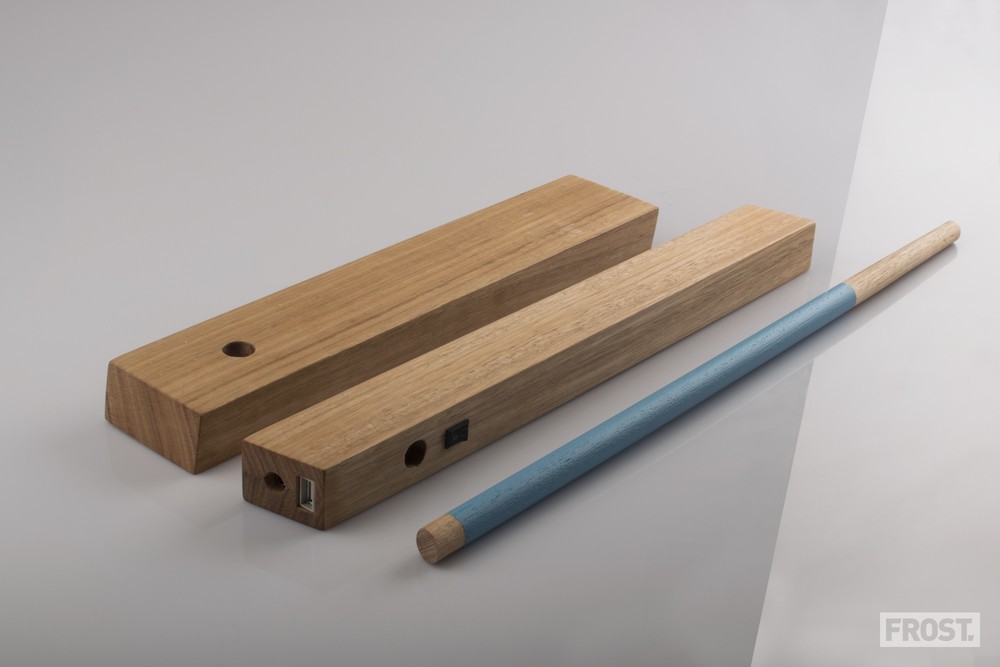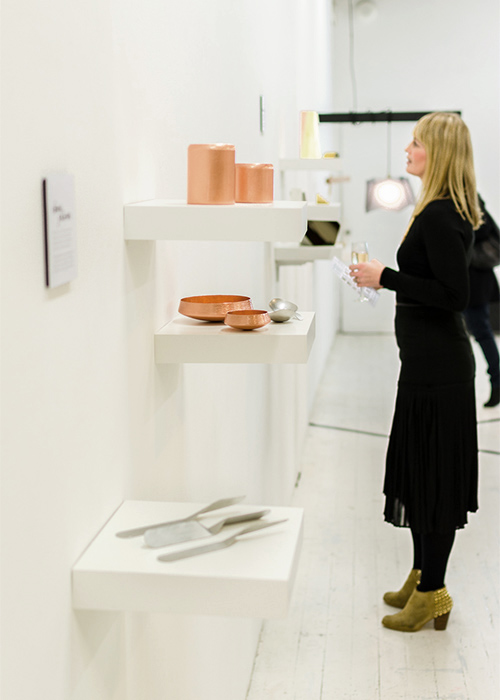For the third year Australian online retailer, Temple & Webster, have presented the Emerging Designer Award with an exhibition of the work of 10 shortlisted designers. While a relatively recent and small award in comparison to Indesign's Launchpad or Workshopped that have been going for many years, as one of three judges who selected the designers, I am delighted with the quality and variety of the work presented.
Shortlisted designers are Stephen Roy, Nicholas Fuller, Alison Jackson, Jack Frost, Andrew Southwood-Jones and Alexander Kashin of daast; Kenny Yong-soo Son of StudioKyss; Elliot Gorham of Noddy Boffin; Chris Gilbert, Chris Haddad and Josh FitzGerald of Archier Studio, Hugh Altschwager of Inkster Maken and the duo Rowan Turnham and Matthew Harding.
The range of work is broad with Kenny Yong soo Son and Alison Jackson coming from jewellery making backgrounds, while Stephen Roy and Nicholas Fuller are studying furniture making having previously studied design. Several of the rest of the designers chosen have studied architecture rather than industrial design but have been drawn to the more intimate process of creating interior products. The objects exhibited therefore range from small hollowware bowls in copper and silver to large furniture pieces and numerous lighting designs. Most of the work is self-produced or made by external manufacturers in small production runs.
The winner of the award will be announced in late August and will receive a $5000 cash prize. For more information on the award and short interviews with the various designers, go to Temple & Webster’s blog
Archier is an architecture and design studio based in Melbourne. The work generally adheres to an elegant minimalist aesthetic. The three founders, Chris Gilbert, Chris Haddad and Josh FitzGerald, all studied architecture and their work in product design stems from a desire to create subtle interior objects to complement their buildings and interiors.
An interest in exploring local materials, trades and processes drives their design process, generally creating an interesting textural outcome. Their interest in the reuse of materials led to their Sawmill house being partially made from blocks of waste concrete for example.
Daast is a multidisciplinary design studio founded by Andrew Southwood-Jones and Alexander Kashin. The pair met while studying architecture at the University of Technology in Sydney and since 2013 have been consistently shortlisted in Australian design competitions such as Indesign’s Launchpad, Workshopped and the IDEA Awards. Their work is highly varied and constantly exploring new ground and materials.
Their most recent concept, the 'Harpoon' joint has led to a collection of stools and tables that show the duo’s incredible commitment to engineering precision while producing an innovative new approach to knock down components.
Both a photographer and a designer, Jack Frost hails from Perth in Western Australia. Raised on a farm, he has always had a fascination on how things work and a particular interest in woodwork, art and photography. Recently completing a Bachelor of Arts in 3D Design at Curtin University, Frost works across both hi-tech and crafted concepts creating designs ranging from simple interior objects in timber to precision photographic accessories.
Canberra born designer Nicholas Fuller comes from a family of talented craftspeople with both his father and grandfather being fitter and machinists / instrument makers. Completing a furniture making apprenticeship with a local Canberra Designer Maker, Scott Mitchell, Fuller has started at the Australian National University (School of Art) studying a furniture design degree but has taken leave after second year in order to take up the position of associate at the Jam Factory in Adelaide.
Fuller’s natural ability in working with timber has led to a collection of furniture pieces where detail and precision have become a key component.
Limestone is not a material that regularly features in design but Hugh Altschwager, who comes from a farming family from South Australia’s Limestone Coast has shown the material to be versatile and exceptionally beautiful. After studying architecture and working in construction management, Altschwager merged the practical and theoretical sides of his work to form Inkster Maken in 2013.
The studio / brand utilises locally sourced natural materials to create long lasting products focusing on the classic geometric forms of cylinder, cone and sphere. Turned from South Australian limestone and a variety of timbers, all of Inkster Maken’s products are designed and hand crafted by Altschwager in Melbourne, Victoria.
Alison Jackson graduated in 2008 from the ANU School of Art, Gold & Silversmithing Workshop and established her own workshop space, Pocket Studio with Lan Nguyen-hoan. The workshop has now developed into a fully equipped Silversmithing studio where Jackson also runs a program of short courses. Designing and hand making jewellery and tableware pieces. Jackson combines traditional silversmithing techniques with a highly contemporary aesthetic. While much of her work is hand raised from flat metal sheets, Jackson has also started to explore more industrial processes as seen in objects such as her ‘Cheese tools’ designed in 2014 and shown at Ventura Lambrate in Milan as part of the Other Hemisphere exhibition.
In 2013 Jackson was runner-up in the prestigious Qantas Spirit of Youth Award, Craft and Object Design category and is a current recipient of an Australia Council 2015 New Work Grant.
Noddy Boffin is the studio and brand set up by Melbourne based designer/maker Elliot Gorham. Gorham studied at the Australian National University Art School, specializing in furniture making and completed an honours year perfecting his craft and honing his design skills. Relocating from Canberra to Melbourne in 2008, Gorham has gained experience in various fields including set building, upholstery, veneer lamination and metal fabrication to further his understanding of form, method and materiality.
Gorham sites his interest in sculpture, life drawing, tool making, art theory, ceramics, gold & silver smithing (to name just a few!) as motivating his methods and aesthetic, His work while highly functional consistently shows a lighthearted quirkiness that sets his work apart from the mainstream of Australian furniture design. Interested in high quality construction methods and the exploration of less obvious material combinations, Gorham currently splits his time between the Noddy Boffin studio in Richmond, Victoria and tutoring at Handsome & Co -School of Woodworking and Design.
Stephen Roy is an Adelaide furniture designer and maker, who completed a two-year Diploma in Furniture Design and Technology at TAFE SA in 2013. Roy is now completing the Associate Training Programme at Adelaide’s JamFactory. - a unique South Australian non-profit organisation, which promotes design and craftsmanship through in house studios, galleries and shops. The furniture Associate Training Programme is headed by well-known Australian designer Jon Goulder and provides advanced teaching and an outstanding workshop environment for a period of two years.
Roy has designed a diverse range of interior objects to date, including a wall clock, modular storage system, coatrack and lighting.
The main focus of South Korea born Kenny (Yong-soo) Son of Studiokyss, is that his objects have ‘life’ and add significance and value to the daily lives of those who use the products. His objects sit comfortably between the decorative and the functional and combine both traditional metalworking craft and contemporary design.
Graduating in Visual Arts at The Sydney College of Arts (SCA) in 2010, where he majored in Metal & Object, Song has subsequently completed a Masters in Design at The University of Technology in Sydney and in 2013 founded his studio and accessories label, Studiokyss.
Rowan Turnham and Matthew Harding met while studying industrial design at Monash University and collaborated on a range of lights called ‘Exo’. Produced by Rakumba Lighting, the LED pendant, wall and table lights are skeletal forms in anodized aluminium finished in various colours. Shown as part of the Melbourne Movement’s exhibition at Salone Satellite in Milan this year, the lights have gained widespread media attention.
A sale of some of the items produced by the selected designers runs until midnight on Monday the 27th July. To purchase items by the nominated designers go to the following address by clicking here:







































